Special thanks to John K. Jordan's and Steve Antonucci's help - and patience.
================================================
There are several "Pyrography Systems" (little, variable power, power supply with plug in "pens") you can buy "ready to go out of the box" which will let you scortch or "burn" lines, dots, simple patterns etc. into wood. A boat load of "pens" with an amazing number of "tips" are available for those units.
Then there's Graeme Priddle's Wood Vaporizor. He doesn't just scortch, or burn or brand wood - he vaporizes it - in a flash of light and a puff of smoke! No wimpy little power supply and delicate little "pen" with this set up. He starts with a 10 amp, 12 volt, car battery charger and makes his own "pen" and bends pretty heavy duty nichrome wire to make his own tips.
If you have seen him work with this tool, or seen a few of his pieces that used this tool, you may have thought "I'd like to do that type of thing on one of my pieces." Then you start looking into what you need to get, or put together. Often the path ends there - there's not a lot of info on this thing. The following is an attempt to fill in some holes in what was out there before.
BUT - before we get to all that - a warning and a disclaimer.
CAUTION
ELECTRICITY CAN HURT - OR KILL - YOU. The following involves both Alternating and Direct Current - "house electricty" and "battery electricity" - and some electrical wiring. It's not rocket science, but it does require some knowledge and understanding of electrical wiring. If you don't have that knowledge and understanding you could a) get hurt or killed and/or b) start a fire that could burn down your shop / garage and maybe your house. Use the following information at your own risk.
DISCLAIMER
The author of, and contributors to, this article assume NO responsibility or liability for the use, misuse or abuse of any of the following information.
Let's start with two basic approaches to making a Priddle Style Wood Vaporizing System using a simple car battery charger (sketches and notes kindly provided by John K. Jordan).
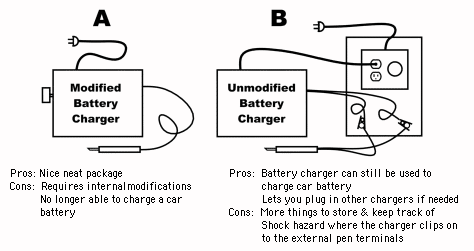
Approach "A" modifies a simple 10A, 12 volt battery charger - INTERNALLY. This involves opening up the case of the charger, making holes in it, installing parts and making wiring connections. The modifications make the battery charger no longer suitable for charging your car battery.
Approaoch "B" makes no modification to the battery charger. You can continue to use your battery charger to charge your car battery - AND - use it as the power supply for a Wood Vaporizer. All the modifications are made EXTERNAL to the battery charger - the battery charger is merely connected TO the modifications.
Though the internals vary from battery charger to battery charger, all of them have a power cord coming into a metal case from a "house electricity" (AC) source and a thicker direct current (DC) cable coming out of tthe case, with clips on the ends to attach it to a battery's terminals. With everything unplugged, if you wire in a "dimmer switch" that can handle 5 amps (600 watts) on the AC side and put in some quick disconnect plugs on the DC output side, you can make one or more plug in pens - and scortch, burn or vaporize wood - with all kinds of burning tips you can make by bending nichrome wire.
Here's Approach A - the neat and tidy, all internal, approach - that means you can't use your battery charger to charge batteries anymore. Sometimes you need to give up something to get something else.

Here are two other methods of connecting the "pen" to the Internally Modified battery charger.
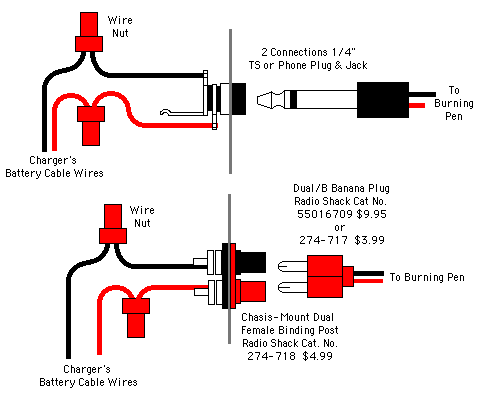
Steve A. asked an obvious question - "Since Approach A's internal changes would make the battery charger no longer useable for charging a car battery - why not just cut of the clips off its cable that used to go to a battery and use them rather than futz with Banana Plugs or Phone Plugs?". The answer of course is DUH! - THAT would work. So there's yet another approach - call it Plan A.0..
For those who prefer photos of parts: photos of parts - kindly provided by John K. Jordan.
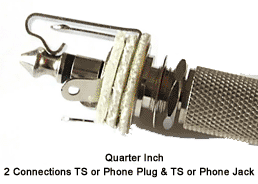
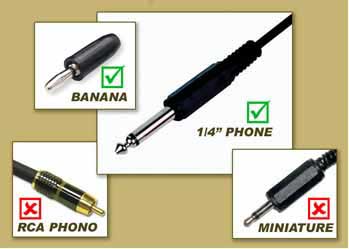 7
7
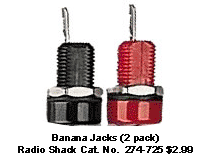

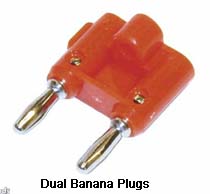
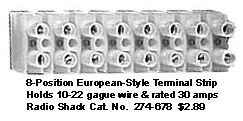
And if you've ever wondered about electrical sockets - John K. Jordan provided the following photos - that may help.

If you want to keep using the battery charger to ALSO charge a car battery, here's Plan B - with all the modifications made EXTERNAL to the battery charger. The following illustrations are based on Steve Antonucci's DIY set up with plenty of help from John on the illustrations
Note: Alternating Current 110 VAC outlets and switches have color coded terminal screws - white/silver, brass/gold and green. Black wires go to Brass terminal screws, White wires go to Silver terminal screws and Green Wires got to Green terminal screws. Remembering this 110V AC wiring convention can come in handy - so reread the previous sentence again. Black To Brass, White To Silver, Green To Green.
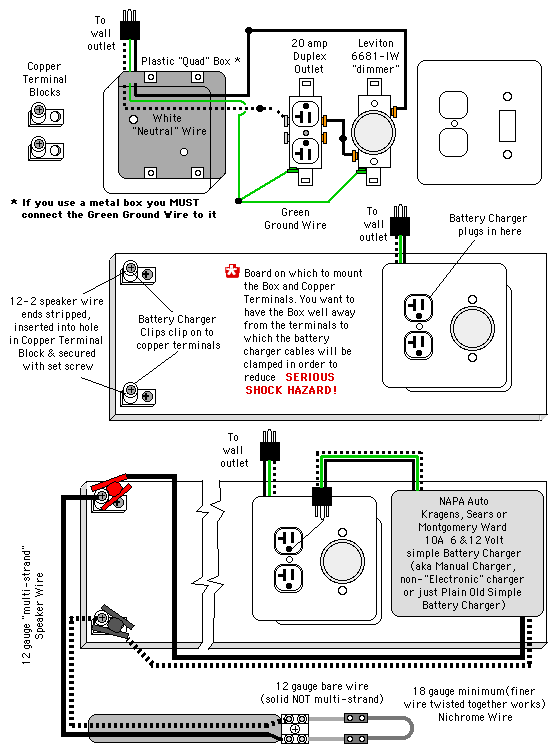
NOTE:
The exposed connections of the battery cable to the "pen's" electrical terminals present a potential for an electrical short circuit - and is a SERIOUS SHOCK HAZARD - just as is when connecting a car battery charger to a car battery. Make the connection BEFORE plugging in the unit - and avoid touching both terminals at the same time - in order to avoid shocking the hell ( and possibly the life) out of yourself.
Here's a photo of Steve's set up - clamped to the tool rest of his lathe.
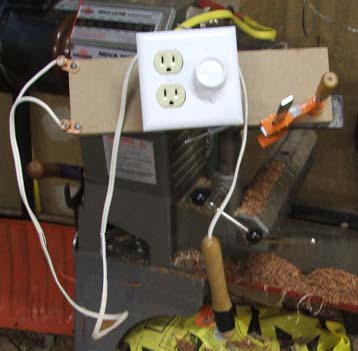
And here's a close up of the working end of Steve's DIY "pen". Note that the bare copper wires between the plastic covered terminals on the end of the handle and the bare terminals connection to the nichrome wire on the pen tip acts as heat sinks, reducing the heat from the hot pen tip before if gets to the plastic insulated terminals.
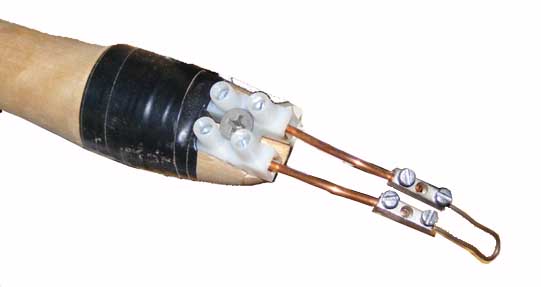
Here's the new handpiece Graemme Priddle came up with. The brazing rod inside the PVC (plastic pipe) handle disipates heat build up in the handle through the use of drilled vent holes in the PVC pipe
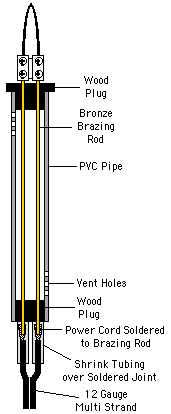
Because this is a DIY device, there will be some Trial and Error work required to get it to work for you. Too much current and / or too small a diameter nichrome wire will destroy your "pen tip" - in a bright glowing red hot instant.
Dimmer swtiches don't come with On and Off labels or any markings to identify how much electrical current it's feeding your pen tip. So - you're going to have to do some experimenting to find out how far you must turn the dimmer nob to get the tip to the temeperature you want. And that setting will change based on how much nichrome wire the tip you make uses. Figure on burning up a few nichrome wire tips before you. You can of course make black pen marks on the dimmer nob and base plate to give you an idea of the "power level" at different nob positions - but you'll still need to tune things to get the desired temperature at YOUR tip for the type of work YOU are doing.
If you're going to work with a single tip and have found the perfect dimmer switch setting for that tip for the scortching/burning/vaporizing you want to do - and don't want to have to keep reseting the dimmer the next time you turn the unit on - here's a solution - for the External version "B" set up. The "duplex outlet" in the external Dimmer & Outlet Box is replaced with a Switched Oultel. You plug the charger into the Switched Outlet and turn the power to it On or Off using the switch. Now you can set the dimmer to your tip ONCE and leave it there - using the Switched Outlet to turn the charger on or off.
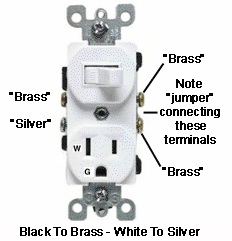
One More Note Of Caution:
Unless your battery charger has some sort of Power Is On / Power Is Off Light, this thing will look the same on or off.
Unless you accidently touch the tip or the exposed copper wires connecting it to the pen or touch both exposed terminals on the External Approach B you have no way of telling if the unit is On or Off. So, to avoid an electrical shock, or a burn - or a fire in your garage/shop - UNPLUG THE UNIT FROM THE WALL OUTLET BEFORE CHANGING TIPS OR WHEN YOU'RE DONE USING IT.
So there you have it - two approaches to making a Graeme Priddle Style Wood Vaporizer System.
If you have questions,comments, suggestions or constructive criticism - please e-mal them to me.